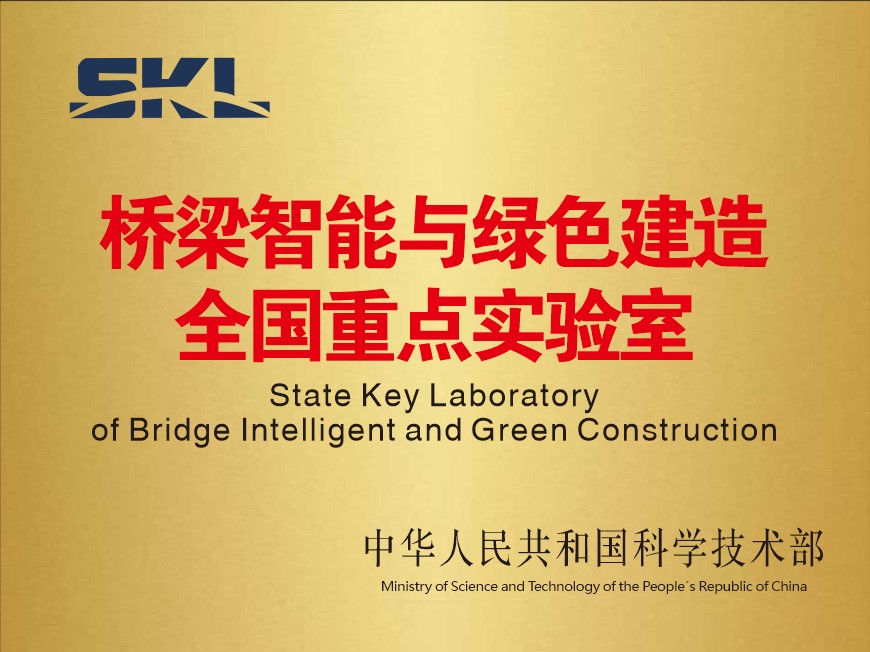

Laboratory Overview
The State Key Laboratory of Bridge Intelligent and Green Construction, aligned with the "Transportation Strong Country" and "Dual Carbon" strategies, focuses on the development of key technologies for intelligent and green bridge construction. It conducts cutting-edge, pioneering, and exploratory research in three main directions: multi-objective optimization intelligent design of bridges; intelligent manufacturing; installation; control of bridges; and green construction of bridges. The laboratory aims to cultivate groundbreaking technologies, overcome significant engineering construction challenges, enhance the international competitiveness of China's bridge engineering, establish a world-leading innovation research platform, and build a national strategic scientific and technological support force. This effort supports the transformation and upgrading of the bridge construction industry and leads to its high-quality development.

Research Direction
(1) Multi-objective optimization of intelligent bridge design
In response to the demand for the evolution of bridge construction technology toward intelligent development, this research addresses the technical challenges associated with the integration of bridge structural design and intelligent technologies. It aims to elucidate the multi-agent collaborative design mechanisms that hinder the convergence of these two technologies, resolving fundamental scientific issues related to the expression and collaboration of high-dimensional, multi-level bridge component agents. The ultimate goal is to establish a multi-agent system for intelligent bridge design.
|
|
(2) Intelligent manufacturing, installation, and control of bridges
Focusing on the intelligent development needs of bridge construction, this research focuses on scientific issues such as digital construction scenarios of bridges and multi-agent collaborative construction. It emphasizes the study of key technologies, including digital twin modeling methods for bridge construction scenarios, automated manufacturing processes in factories, precise control of onsite construction processes, and intelligent control of construction robots/equipment.
|
|
(3) Green bridge construction technology
Focusing on the entire chain of bridge construction, which encompasses materials, design, and construction, this field concentrates on the quantification and enhancement of green performance in bridge construction. It investigates the quantification standards and assessment methods for bridge carbon emissions and green construction, the utilization of bridge solid waste and the development of new green building materials, low-carbon bridge structures and technologies for enhancing green performance, and green construction techniques for large and complex bridges. The emphasis is on overcoming several technological bottlenecks, such as the intelligent accounting and assessment of green performance driven by big data, the efficient classification and utilization of industrial slag and construction waste, the design methods and optimization models for low-carbon bridges throughout their lifecycle, new technologies for bridge vibration reduction and noise control, and new measures for anticorrosion and energy savings. Additionally, it includes the development of new green processes in bridge construction. The goal is to establish industry standards for green construction that align with national development and bridge characteristics, forming a comprehensive, multi-dimensional green performance enhancement technology system that spans materials for design and construction.
|
|
Research Team
Building upon its existing core backbone and talent pool, the laboratory aims to construct a research team that is clearly tasked, intergenerationally integrated, professionally structured, and efficiently united in response to significant national strategic demands. The current permanent staff comprises 218 individuals, including 183 researchers, 14 technical support personnel, and 21 administrative managers, covering a range of disciplines, such as civil engineering, mechanics, electronics, information technology, and artificial intelligence, all of which are pertinent to the research directions pursued.
Research Facilities
The laboratory currently occupies a total area of 31,200 square meters, with experimental facilities that are distinctly functional and rationally arranged, ensuring the smooth and orderly operation of the laboratory's scientific endeavors. It boasts the largest six-degree-of-freedom earthquake simulation platform in China and the second-largest in the world, the world's largest atmospheric boundary layer wind tunnel, and the largest multifunctional bridge wave and current experimental pool. The laboratory is equipped with a Class A shared data center featuring 120 high-density server cabinets and possesses experimental platforms for the development of new bridge materials, multifunctional fatigue testing of bridge structures, and the development of dynamic safety control for bridge structures. It has undertaken scientific research for over two hundred significant domestic and international bridge projects, including 12 of the world's top ten suspension bridges and top ten cable-stayed bridges, making its experimental and research and development conditions comprehensive and well equipped.
|
|